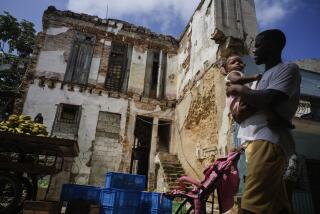Was Home of Dictator Fulgencio Batista : Former Havana Palace Now Museum of Revolution
- Share via
HAVANA — Outside an ornate white marble palace in central Havana a Soviet-built Sau-100 tank stands proudly.
Fidel Castro is said to have sunk a U.S. ship with the tank during the ill-fated 1961 Bay of Pigs invasion.
From 1920 until the 1959 Cuban Revolution the palace was the presidential residence. But Castro shunned the huge building because of its symbolism, and now it is the Museum of the Revolution.
Founded in 1975 and reopened this year after extensive renovations, the museum includes about 2,000 artifacts, the legacy of the revolution.
Fight for Independence
Among them are a broken pipe, outdated rifles and hastily scribbled notes that bear witness to the guerrilla war that led to the founding of the first Marxist government in the Americas.
According to the museum’s director, Lt. Col. Nelson Martinez Amador, the museum was designed to extol the Cuban people’s fight for independence, starting with the first war of liberation from Spain, which began in 1868.
The museum, Martinez Amador explained in an interview, is being expanded from 25 rooms to 38 and will focus on “the progress of socialism.”
A temporary exhibit hails the “historic victory” of Angolan forces and their Cuban allies over the “South African aggressor” at Cuito-Cuanavale in southern Angola.
Site of Heavy Fighting
Cuito-Cuanavale was the scene earlier this year of heavy fighting between the Cuban and Angolan troops and rightist Angolan rebels, who have South African and U.S. backing.
Three bits of metal, said to be fragments of a South African Mirage fighter plane downed over Angola, are shown alongside photographs of Cuban soldiers and a one-page letter, dated April 3, 1988, of a Cuban father to his son.
But the largest part of the museum, which faces the 16th-Century fort of El Morro guarding the narrow entrance to the harbor, is dedicated to the guerrilla war that Castro and his bearded revolutionaries waged against dictator Fulgencio Batista.
Now, where Batista once gave sumptuous receptions, up to 1,200 visitors a day shuffle by. They view the handwritten notes scrawled by Castro and the rifles fired by his men in the Sierra Maestra Mountains in the late 1950s.
Che’s Pipe
The broken pipe belonged to Ernesto (Che) Guevara, the Argentine-born guerrilla killed in Bolivia and now revered as a national hero in Cuba.
Two life-size wax statues, of Che and of guerrilla comrade Camilo Cienfuegos, occupy the last room on the tour.
In military fatigues, they “are sweating, they are tired but they nonetheless carry on with the struggle,” the guide said, reciting a well-learned, and at times poetic, text.
To Cuban schoolchildren, all born after the revolution, Che’s personal belongings, such as the inhalator he used against asthma, are as much a part of their national heritage as Churchill’s cigars are to the British or Napoleon’s hats to the French.
Moncada Barracks Attack
Castro’s 6-year-fight began with the July 26, 1953, assault on the Moncada barracks in Santiago, Cuba.
Celebration of the 35th anniversary of that historic but disastrous operation--commemorated at the museum with a scale model of the barracks--have already started.
The 165 attackers suffered heavy losses. Castro and his brother Raul were arrested a few days later and jailed.
More to Read
Sign up for Essential California
The most important California stories and recommendations in your inbox every morning.
You may occasionally receive promotional content from the Los Angeles Times.













